Intel plans Xe consumer graphics for laptops first, a discrete card in 2022 - cannadygles1968
Intel's upcoming Atomic number 54 HPG discrete graphics card will so have hardware ray tracing, the company confirmed connected Wednesday. The catch? That new discrete GPU for gamers won't actually come out until 2021, while laptops will get Xe L-P first.
Still, Intel's Raja Koduri (senior vice president, top dog designer, and general manager of Architecture, Graphics and Software) was visibly giddy to declare that Intel would soon have a GPU targeted to incomparable of the loudest crowds on the Internet: enthusiast Microcomputer gamers. "We live enthusiast gamers are the hardest bunch to impress. They love products that have the best performance, best performance per watt, carrying out per clam and latest, greatest features all concurrently," Koduri said. "I'm thrilled to share with you that this GPU is instantly in our labs as we verbalize, and I behind't hold to get my work force on it soon."
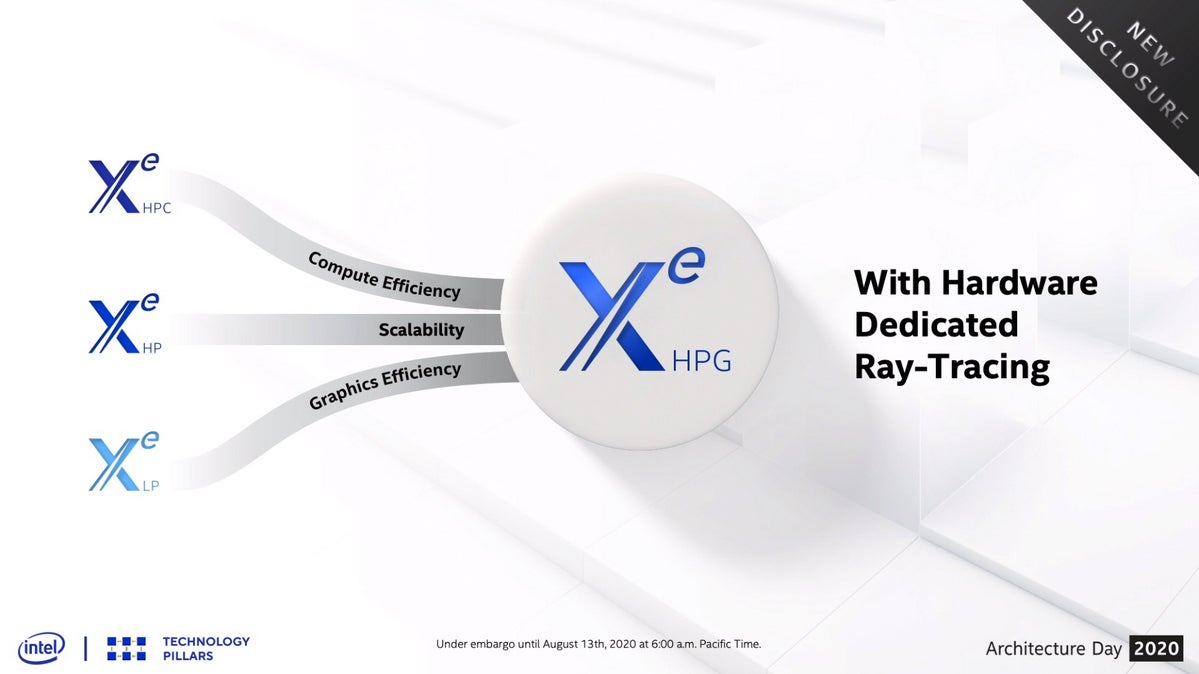 Intel
Intel Intel's 2021 Xe HPG will use building blocks from the company's laptop and high-carrying out Xe nontextual matter. And yes, it'll birth hardware beam of light tracing.
For dramatic issue, Koduri finally added: "And yes, this GPU will have support for hardware accelerated ray tracing along with several breathtaking features you wait for a GPU."
Inside information of the new Atomic number 54 HPG weren't disclosed, simply we do have it off it uses conception cues from Intel's Xe HPC for high-performance low-pitched learning computing, the Xe HP that's organized for intensifier tasks such as real-time media encoding, and the Xe LP that's going into laptops.
Koduri also said Xe HPG will use a entirely new GDDR6 computer memory controller, unlike the Xenon HP and Xe HPC, which use high-bandwidth memory (HBM). Koduri said that's a good thing: "I still have the scars happening my back disagreeable to bring expensive memory subsystems the like HBM to gaming, at least twice," he said. Koduri is referring to his previous stint at AMD, and the company's long and tortured relationship with HBM in consumer GPUs.
Intel also said the Xe HPG won't be manufactured by Intel, instead expression it would be "external." Naturally this leads to speculation As to which pleasing will get the work done.
The antepenultimate bit of info happening Intel's long-acting-awaited discrete GPU came in a Q&A with media after the presentation. Koduri aforementioned Intel plans to vie from the top to the bottom of the GPU market, merely it's sticking with its previously stated end of getting Xe graphics first into the arena with the greatest demand: Laptops.
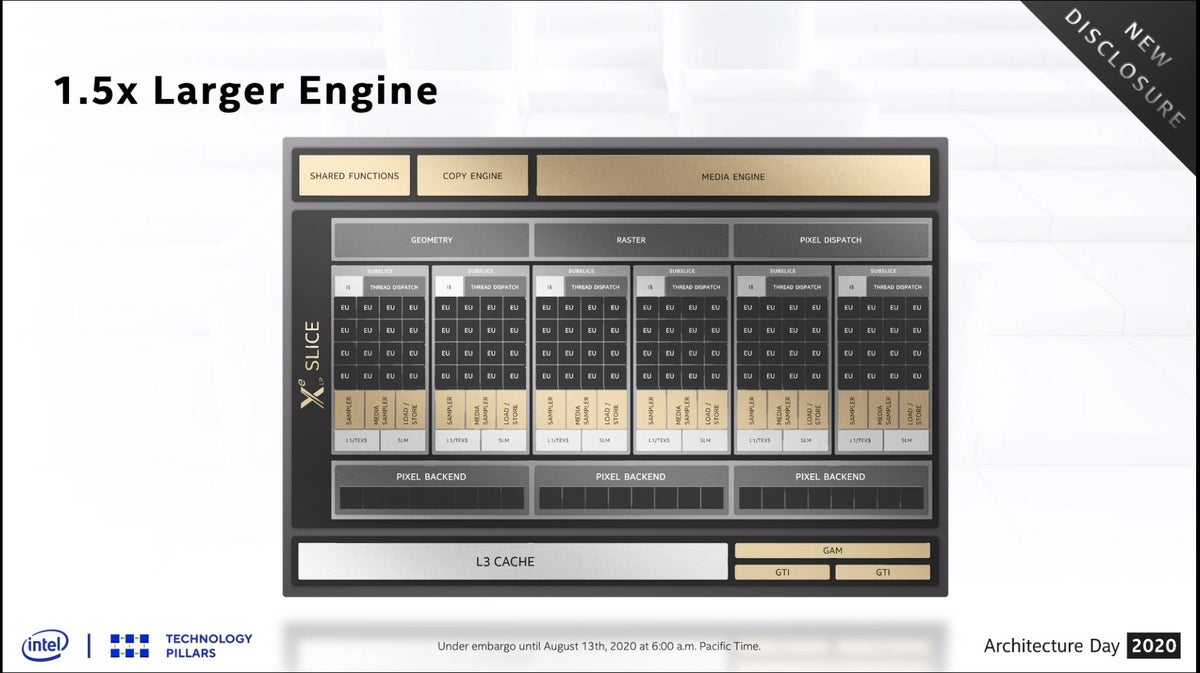 Intel
Intel You'll first see Intel Xenon graphics in laptops, a ground-rising redesign featuring the Xe LP with 96 EUs and in effect about 2X the performance of Ice Lake graphics.
Intel Xe LP comes first
That's the right way: What will come for the first time for consumers is Xe LP, which will be used in laptops featuring the future Tiger Lake CPU.
Intel's Saint David Blythe aforementioned the goal was to offer 2X the performance over the 10th-gen Ice Lake's Gen 11 artwork, while non growing the die space and also not increasing the exponent consumption. "Soh effectively this means…increasing performance per millimeter squared, public presentation per watt and performance per flop at the same time," Blythe said. Blythe described IT as a "daunting" task that needful a ground-up redesign, with the architecture, small-architecture, and process teams all working together to achieve their goals.
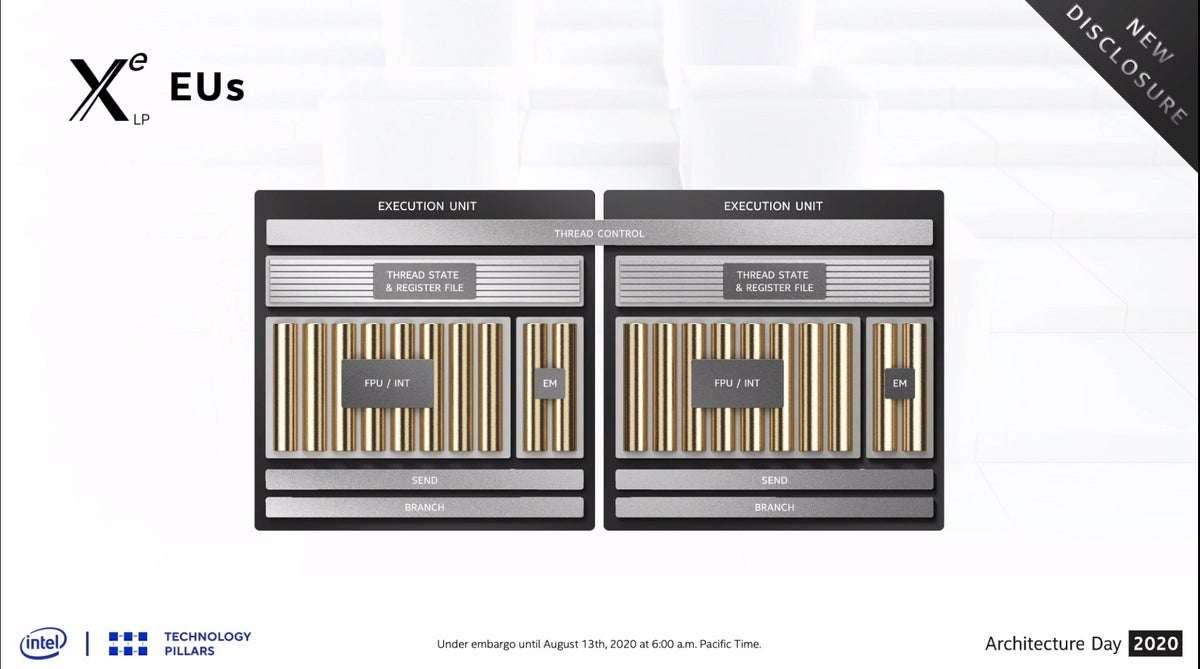 Intel
Intel Intel's new Xe LP features execution units that feature a shared thread controller and are essentially "wider," which acquired immune deficiency syndrome efficiency while profit-maximizing performance.
Blythe said to hit the object, they decided to grow the engine by 1.5X, consequent in 96 execution units vs. the 64 execution units of the Gen 11 graphics in the 10th-gen Ice Lake CPUs. This took Xe LP most of the way toward its goal of 2X the performance over Gen 11 Ice Lake graphics. The residue mostly comes from the improved transistors and metallike stack Intel utilized to work up the cores, as well as bottlenecks removed from the past conception.
For example, a greater dynamic chain means Atomic number 54 LP European Economic Community's will hit some higher clock speeds across the entire band. The current Iris diaphragm Plus graphics in a Core i7-1065G7 has a base time of 300MHz with a boost time of 1.1GHz. Intel didn't pronounce exactly what clocks the new Xe LP EUs will run at, but it's clear it'll exceed 1.7GHz on boost. That hike clock will also take more power, but the efficiency of the design means the new Xe LP EUs will run at about 1.6GHz spell consuming the same power as the 10th-gen Ice Lake running at its max boost of 1.1GHz. That would be roughly a 45-percent higher clock boost.
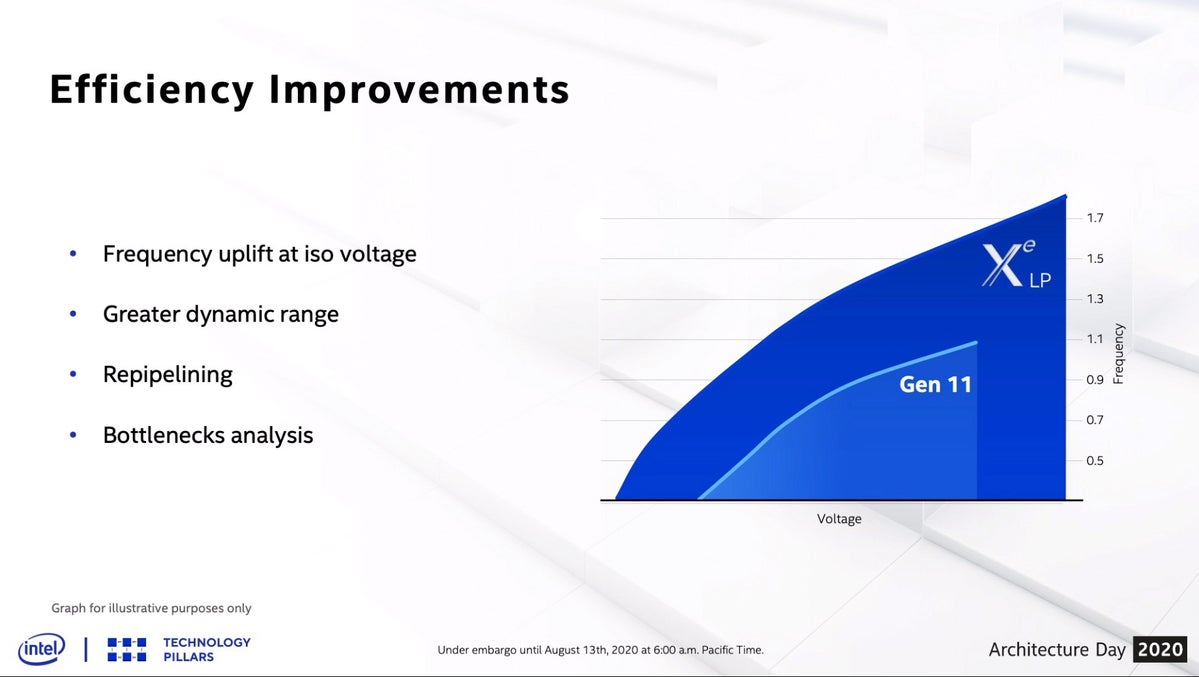 Intel
Intel The efficiency of the new Xe LP for laptops agency IT has a greater "dyamic grade," and so it can employment little power while producing more carrying out than 10th-gen Ice Lake art. It bum also boost far higher.
What it all substance: Faster integrated graphics gaming
What Intel's Xe LP adds astir to is a fairly beefy increase in performance over Intel's integrated graphics formula, which has long been the butt of jokes among gamers.
In demonstrations the company showed Xe LP playing popular games such as PUBG and AAA games such as Battlefield V. Intel was sand-bagging, also: The performance of Xe L-P was with the chip shot limited to a 15-James Watt TDP, while the 10th-gen, Gen 11 artwork Ice Lake laptop was set for a 25-James Watt TDP. That obviously implies that if a laptop can offer 25 watts of chilling, it should offer even more gaming operation.
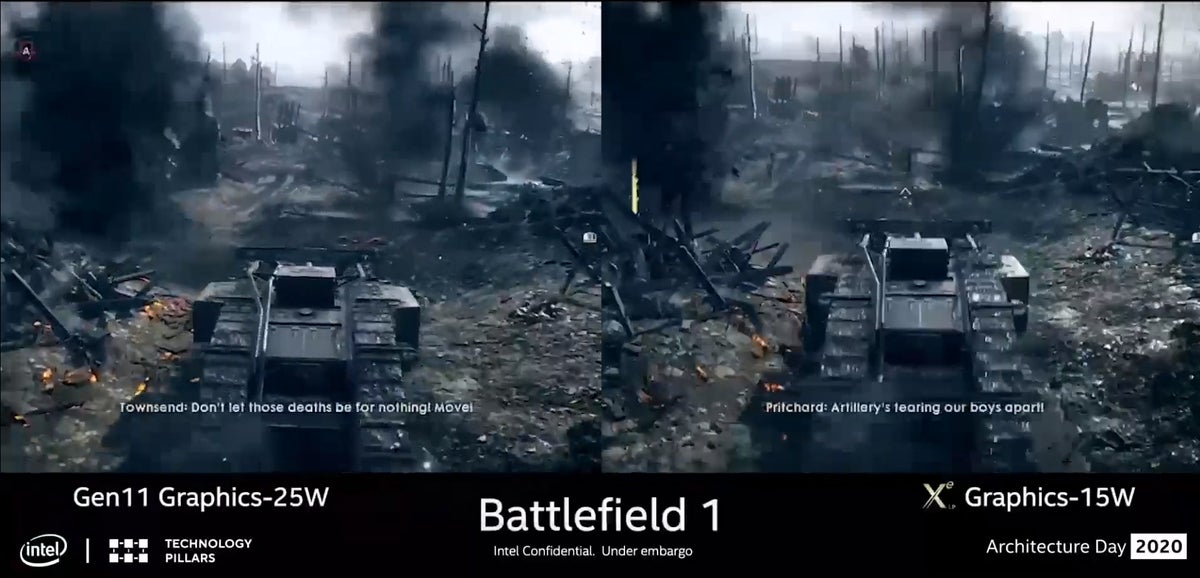 Intel
Intel Intel's Atomic number 54 LP will offer higher performance than its previous Gen 11 nontextual matter in Ice Lake CPUs, while consuming less power.
Intel was rattling coy about the performance of the Xe LP, but in a voiceover during Battlefield V, the Intel teller says: "With Xe you can expect outstanding performance across a breadth of games including previously unachievable game play happening many AAA titles in that form factor."
Because tech companies can't make carrying into action claims without lawyers parachuting in through the window setose with lawsuits, that financial statement seems to imply that Xe LP will offer performance beyond both 10th-gen Ice Lake laptops as well every bit AMD's on-line Ryzen 4000 chips. But bank bill the phrase "form factor:" Is Intel referring to a 13-inch laptop or a 14-inch laptop? There can be a world of difference between those deuce sizes.
Uncomparable other X factor in Intel's demo is what memory engineering the Xe LP used. Intel has added support for LPDDR5-5400 RAM, while the Tras Lake and Ryzen 4000 laptops are limited to LPDDR4.
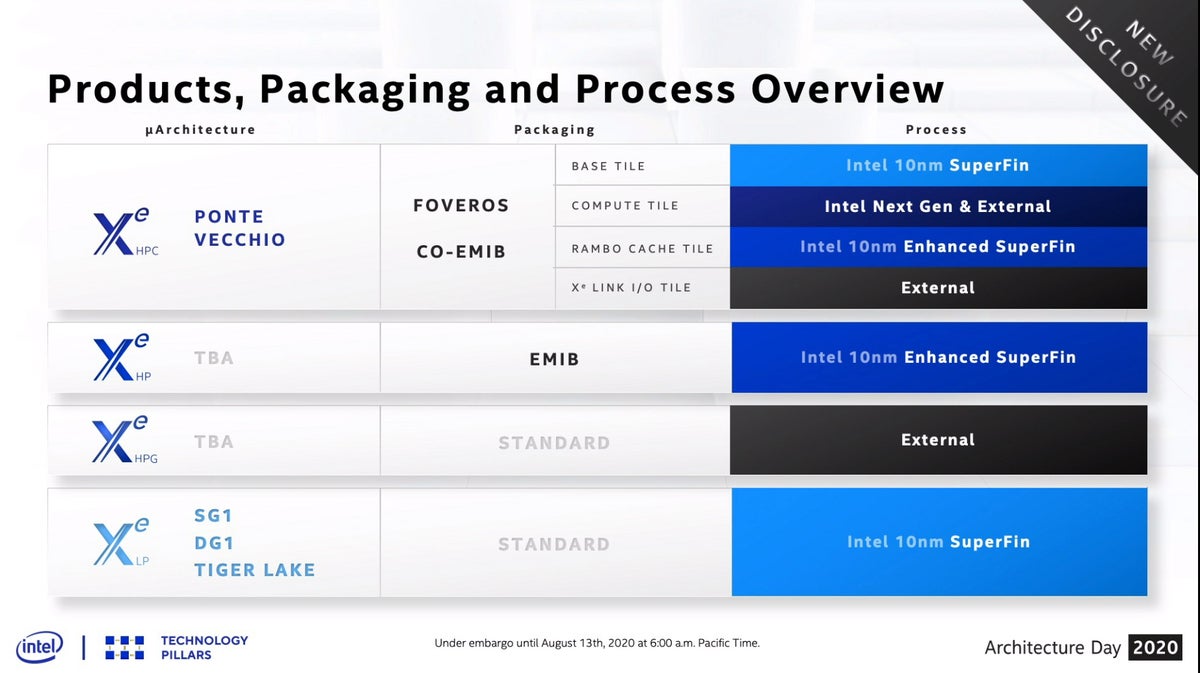 Intel
Intel Intel's first separate GPU in decades will be made by an external fabulous rather than the company's own.
No irradiate tracing in integrated graphics laptops (yet)
One last detail that should beryllium said: Hardware-accelerated ray tracing will be in the discrete GPU due next class, just it won't Be in Tiger Lake/Xe LP-supported laptops when they are unveiled in September. There's hope: When asked whether hardware ray trace could live done in an integrated chip, Intel's Blythe responded, "IT's not that IT can't do it, information technology's more about when is the right-wing time."
This story was updated at 8:57 AM with Intel-supplied video of XeLP gameplay.
Source: https://www.pcworld.com/article/393352/intel-plans-xe-graphics-for-laptops-first-discrete-card-in-2021.html
Posted by: cannadygles1968.blogspot.com

0 Response to "Intel plans Xe consumer graphics for laptops first, a discrete card in 2022 - cannadygles1968"
Post a Comment